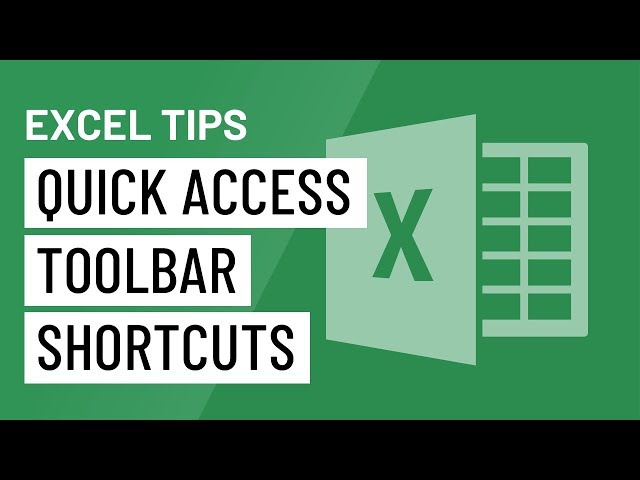Navigating Excel with Ease: An In-Depth Guide to Quick Access Toolbar Shortcuts

Introduction:
Microsoft Excel, a cornerstone in the world of spreadsheets, is celebrated for its robust features that streamline data analysis and management. The Quick Access Toolbar (QAT) is a dynamic element in Excel, offering users a convenient space to place frequently used commands and shortcuts for enhanced accessibility. In this extensive guide, we will delve into the intricacies of the Quick Access Toolbar, exploring its basic functions and unveiling a plethora of shortcuts that can significantly boost efficiency. Mastering the Quick Access Toolbar empowers Excel users to navigate their workbooks with unprecedented speed and ease.
I. Understanding the Quick Access Toolbar:
A. Introduction to the Quick Access Toolbar:
- The Quick Access Toolbar is a customizable toolbar located above the Excel Ribbon.
- It provides quick access to frequently used commands and shortcuts, enhancing user productivity.
B. Customizing the Quick Access Toolbar:
- Users can personalize the Quick Access Toolbar by adding or removing commands.
- Customize the toolbar to suit your specific workflow and preferences.
II. Basic Quick Access Toolbar Functions:
A. Adding Commands:
- Right-click on any command in the Ribbon.
- Select “Add to Quick Access Toolbar” to add the command to the toolbar.
B. Removing Commands:
- Right-click on a command in the Quick Access Toolbar.
- Choose “Remove from Quick Access Toolbar” to remove the command.
C. Rearranging Commands:
- Customize the order of commands in the Quick Access Toolbar.
- Right-click on a command and select “Move Up” or “Move Down” to rearrange.
III. Common Quick Access Toolbar Shortcuts:
A. Save (Ctrl + S):
- The Save command can be added to the Quick Access Toolbar for quick access.
- Use the shortcut “Ctrl + S” to save changes without navigating the Ribbon.
B. Undo (Ctrl + Z) and Redo (Ctrl + Y):
- Add Undo and Redo commands to the Quick Access Toolbar.
- Employ the shortcuts “Ctrl + Z” and “Ctrl + Y” for quick undo and redo actions.
C. Print (Ctrl + P):
- Include the Print command in the Quick Access Toolbar.
- Use the shortcut “Ctrl + P” to initiate the printing process.
D. Copy (Ctrl + C), Cut (Ctrl + X), and Paste (Ctrl + V):
- Add Copy, Cut, and Paste commands to the Quick Access Toolbar.
- Use the shortcuts “Ctrl + C,” “Ctrl + X,” and “Ctrl + V” for rapid copying, cutting, and pasting.
IV. Advanced Quick Access Toolbar Shortcuts:
A. New Workbook (Ctrl + N):
- Add the New Workbook command to the Quick Access Toolbar.
- Use the shortcut “Ctrl + N” to create a new workbook instantly.
B. Quick Chart (Alt + F1):
- Add the Quick Chart command to the Quick Access Toolbar.
- Use the shortcut “Alt + F1” to generate a quick chart without navigating the Ribbon.
C. Insert Function (Shift + F3):
- Add the Insert Function command to the Quick Access Toolbar.
- Use the shortcut “Shift + F3” to quickly access the Insert Function dialog.
D. AutoSum (Alt + =):
- Incorporate the AutoSum command into the Quick Access Toolbar.
- Use the shortcut “Alt + =” for swift summation without navigating the Ribbon.
V. Troubleshooting and Common Challenges:
A. Toolbar Customization Limitations:
- Users may encounter limitations when customizing the Quick Access Toolbar.
- Explore Ribbon customization options or use alternate methods for specific commands.
B. Inconsistencies Across Devices:
- Customized Quick Access Toolbar settings may not sync across different devices.
- Manually replicate toolbar customizations on each device to maintain consistency.
VI. Conclusion:
The Quick Access Toolbar in Microsoft Excel is a potent tool for optimizing workflow and boosting productivity. This comprehensive guide has explored the basic functions of the Quick Access Toolbar, delved into common and advanced shortcuts, and provided insights into troubleshooting and customization. By mastering the Quick Access Toolbar and tailoring it to your specific needs, Excel users can navigate their workbooks with unparalleled efficiency, saving valuable time and streamlining their workflow. Embrace the power of the Quick Access Toolbar, experiment with various shortcuts, and elevate your Excel experience by making frequently used commands just a click away.





